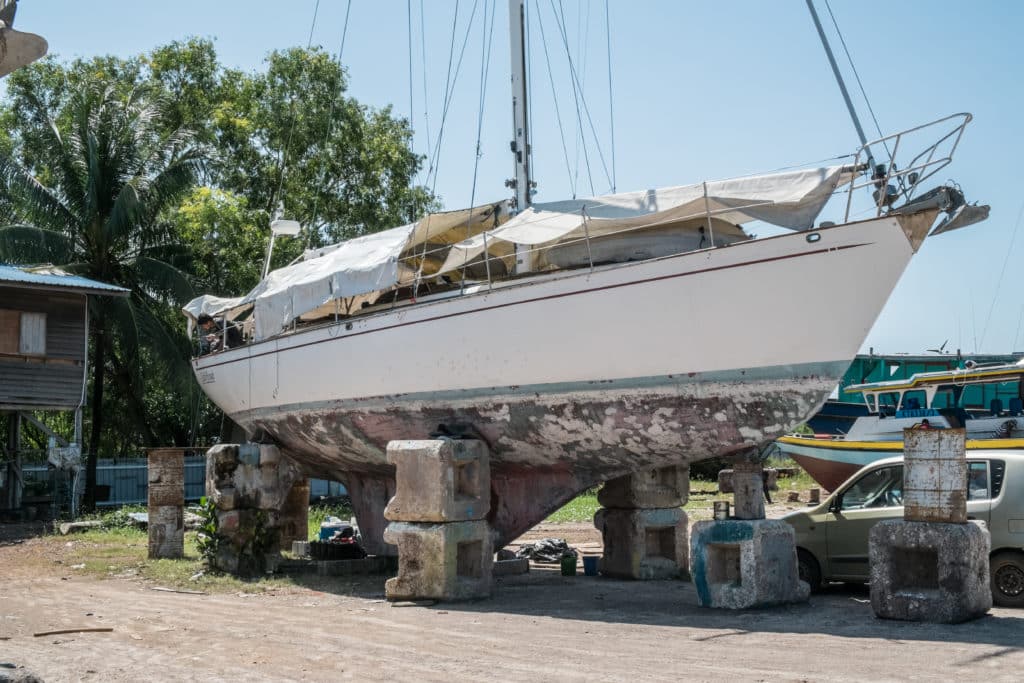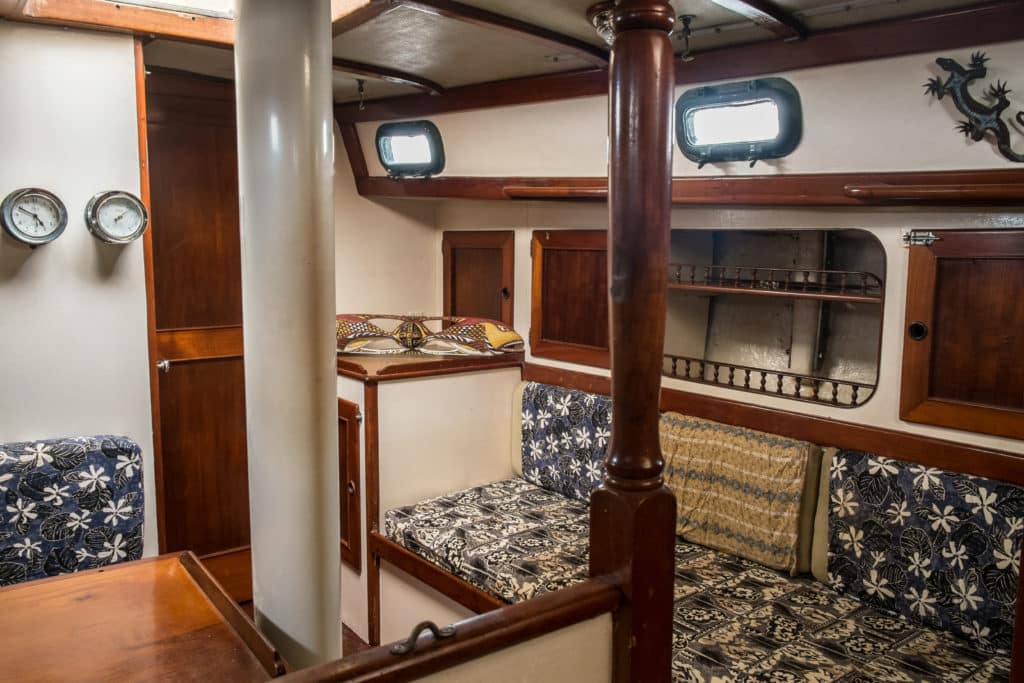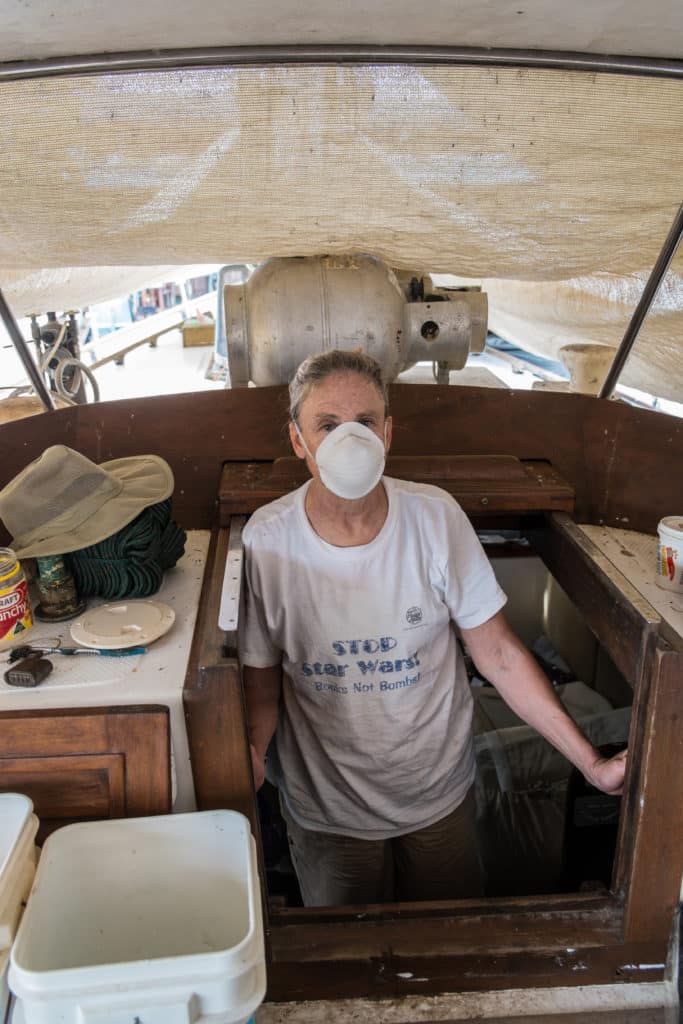
For the first time in years, I could hear water chuckling against the hull, just a few inches from my ear. Two days before, my plane had circled snow-covered roofs in Brooklyn, New York. Now I was on a friend’s boat in Kota Kinabalu, in northern Borneo, and soon the tropic heat would chase me out of my bunk. I lay motionless and thought about what my friend had said the previous night, after spending a week in the boatyard where Oddly Enough, the beloved Peterson 44 my husband and I spent 10 years crisscrossing the South Pacific aboard, was hauled out. “I couldn’t bear to go near her. She looked so derelict,” he had said.
I traced the bright outline of sun coming through a port and wondered what to do. My husband, Tom, and I had returned to Borneo to make Oddly Enough salable, something we should have done sooner rather than leaving her on the hard for three years of burning sun and tropic rains. If her condition was truly as bad as my friend said, maybe the only thing to do was tow her into Kudat Bay, open the through-hulls and let her sink. In northern Borneo, there aren’t many options when you hit the end of the line. We could sail her to Langkawi, but she needed work to get there, and then what? We’d still be on the other side of the world, trying to sell her.
Oddly’s boatyard was three hours north of Kota Kinabalu. Tom and I rented a car, took our time on the awful parts of the road, and still arrived with plenty of daylight. I couldn’t bring myself to go directly to the yard where Oddly Enough sat on the hard. Jet lag and shell shock from our friend’s description, along with the dismissive pessimism of a local man we talked to about selling the boat, were freaking me out. So Tom and I checked into a much nicer hotel in downtown Kudat than we would have a couple of years ago, and the next morning we drove our small, rickety rented car over the ruts into Penuwasa Shipyard. It was winter and the rainy season, and in the morning gloom, Oddly Enough loomed very tall, surrounded by squat wooden fishing vessels in various stages of repair. We pulled around the bow of a boat and bounced to a halt.
My stomach started to unknot. Oddly Enough didn’t look so bad. Her full covers were intact, unlike the shredded tarps on a nearby yacht. We’d alerted our local caretaker that we were coming, and he had a ladder against the hull waiting for us. With shaking hands, I undid the companionway lock and pushed back the hatch. I was greeted with the same old-boat smell: a bit of mildew, a bit of diesel and a lot of dust. After five minutes of checking that everything was superficially as we had left it three years earlier — a small miracle, really — we climbed down and ran whooping to the car, then spent the day sightseeing.
To us, Oddly Enough was the same boat. We knew her faults, her good sailing qualities, and also that her interior was shabby, because we had put everything into making her seaworthy. After our time away, we were very much aware of how she might look to others, but in Kudat, we came to believe it was a mistake to give her up. All the old zest for sailing flooded back. It was easy to forget that we had left the boat to try to settle elderly parents in better living conditions, and to take a break to see if we really did still want to sail.

Three months later, when we left her on the hard for a second time so we could head back home, Oddly Enough‘s resurrection was obvious to everyone who saw her. We’d cleared years’ worth of extraneous equipment from her lockers, painted her interior, polished and waxed her hull, and touched up the paint that was protecting her woodwork. Her engine was functioning. She looked terrific. We even had thoughts of raising her price. We also daydreamed of returning in the fall — perhaps changing out her engine or getting the new mainsail we’d promised ourselves. As happens among cruisers, we’d made new friends and connected with old ones, and visions of destinations danced in our heads.
The new resolve lasted amazingly long. But by fall, when we should have been making plans to return to Borneo if we were truly serious about cruising again, we were once more embroiled in land life. And I wasn’t excited to go back to Asia to curious visitors in canoes, always being the outsider, always behind in the language. Tom didn’t want to be responsible for Oddly Enough‘s physical being. Why all the waffling? Perhaps, as a friend said, people get stuck in Southeast Asia.
Or maybe, as I believe, it’s hard to quit cruising. Lots of people write articles about sailing, me included. Cruisers are living the dream. Who hasn’t been told, “Oh, I wish I could do what you are doing”? We know it’s a fantastic adventure.
No one tells you how to stop cruising, though. Or how to reconcile the new life with the old. Why relief at leaving the boat behind isn’t such a bad thing.
So Oddly Enough stayed on the market. She was a hard sell, and it was a disappointing time to find buyers. She’d been put away ready to pick up cruising again, not to sell. Initially the makeover in Kudat didn’t have any apparent effect. Her biggest drawback was location. Penuwasa is hot, dusty and foreign. The Tip of Borneo is off the usual circuit for American boats. Australians cruise to Sabah, but Penuwasa doesn’t attract weekend tire-kickers like marinas and boatyards do on more populated coasts. Without a major investment in time and money, we couldn’t solve location. If we were going to that length, we might as well go cruising again.
We’d been dropping the price since we’d first listed Oddly Enough, and by the time Tom and I visited her before the refit, we were down by half. Every year we paid thousands of dollars in storage. Every year she aged. The KP 44 website, where we listed Oddly Enough, attracted dedicated Peterson buyers but didn’t reach the wider boat market. Finally we dropped the price ridiculously low and put her up on Boat Trader. Soon a New Zealander made a serious offer, and a few days later, an American couple in the Philippines really wanted her, all sight unseen. Immediately, old, powerful feelings came up. The reality of selling made me panic. As long as we’d had Oddly Enough, we’d had an excuse to escape and not stay home 12 months a year. We had a purpose or at least an “illusion of purpose” in life, as Joshua Slocum once said.
Yet somewhere along the way after leaving Oddly Enough, we’d stopped getting on with our lives, stopped making decisions about what to do next. We’d lost the thread to what life was like before cruising, because we couldn’t let go of the dream. Oddly Enough even interfered with sailing. We had a Cape Dory 25 in excellent condition sitting on the hard in Maine; I dreamed of experimenting with minimalist cruising in New England. But we couldn’t afford two boats, so they both sat while we set our priorities elsewhere. We never even sailed during our time in Kudat last year. We spent time on people’s boats just to sleep or socialize, and once to help friends move from the yard to the dock.

Now, finally, we had two buyers who weren’t backing down. Oddly Enough was in good but not sailaway shape. At the new price, she was such a steal that we could stick to the conditions we set: The boat would be sold as is, there would be no sea trial, and we wouldn’t go to Borneo to meet the buyers.
The couple from the Philippines visited first and absolutely loved her. Of all the things to then happen, lightning struck Oddly Enough‘s mast, blowing a few small holes in her side. This was where having a caretaker, other nearby cruisers and sensible buyers was crucial. Fortunately, the hull damage was reparable, and the electronics were fine (we always remove or seal up electronics when we leave the boat). Both prospective buyers made acceptable bids after seeing her, but the Kiwi had right of first refusal. As he hung in the air and then finally requested assurances that the engine would run, I wondered if we should have gone with the people in the Philippines. Tom emailed the Kiwi a reminder that Oddly Enough was listed as is, mentioning a Peterson in New Zealand going for $150,000 and the existence of other buyers in the wings, and within a day, the deal was patched up.
The realities of international sales took another couple of weeks to sort out, but in the end, both sides were trusting. The buyer transferred money in some way that lowered his exchange differential, and we mailed off the signed paperwork. I’m sure he will have questions when he gets to Oddly Enough, but that’s for later.
It’s still very hard to give up Oddly Enough — even more so for Tom than for me. Sometimes it does seem that we are giving up the dream. So what convinced me that selling Oddly Enough wouldn’t cause my world to end?
I could say simply time and distance. But there was a moment when I counted the time I’ve spent cruising — including actively sailing and getting boats ready to cruise — and realized it represented 20 years of my life. That’s longer than I’ve done anything else except be married. So if I choose to do something else for a while, it’s OK. It doesn’t mean the end of sailing or even cruising unless I want it to be. Plenty of people have gone back after a hiatus.
During our last season on board Oddly Enough, at Sutera Harbor in Kota Kinabalu, a sailor named Johnny, who performed in the club restaurant, sang Rod Stewart’s “Sailing” one night as we dined. The schmaltzy tune about sailing to be free can still raise a teary-eyed excitement in me.
Ann Hoffner and her husband, Tom Bailey, spent 10 years cruising aboard Oddly Enough. They are currently looking for a new sailboat.








